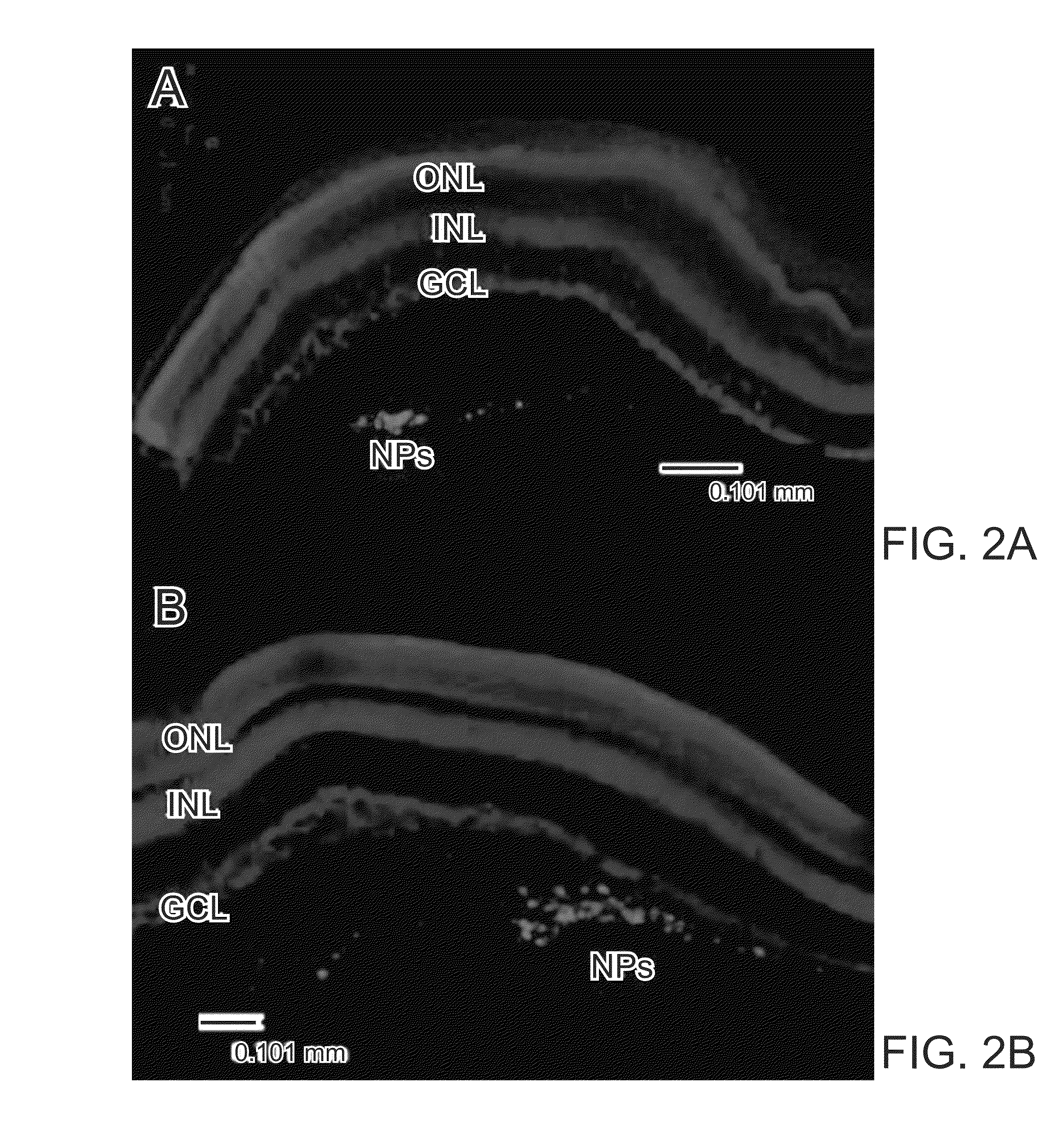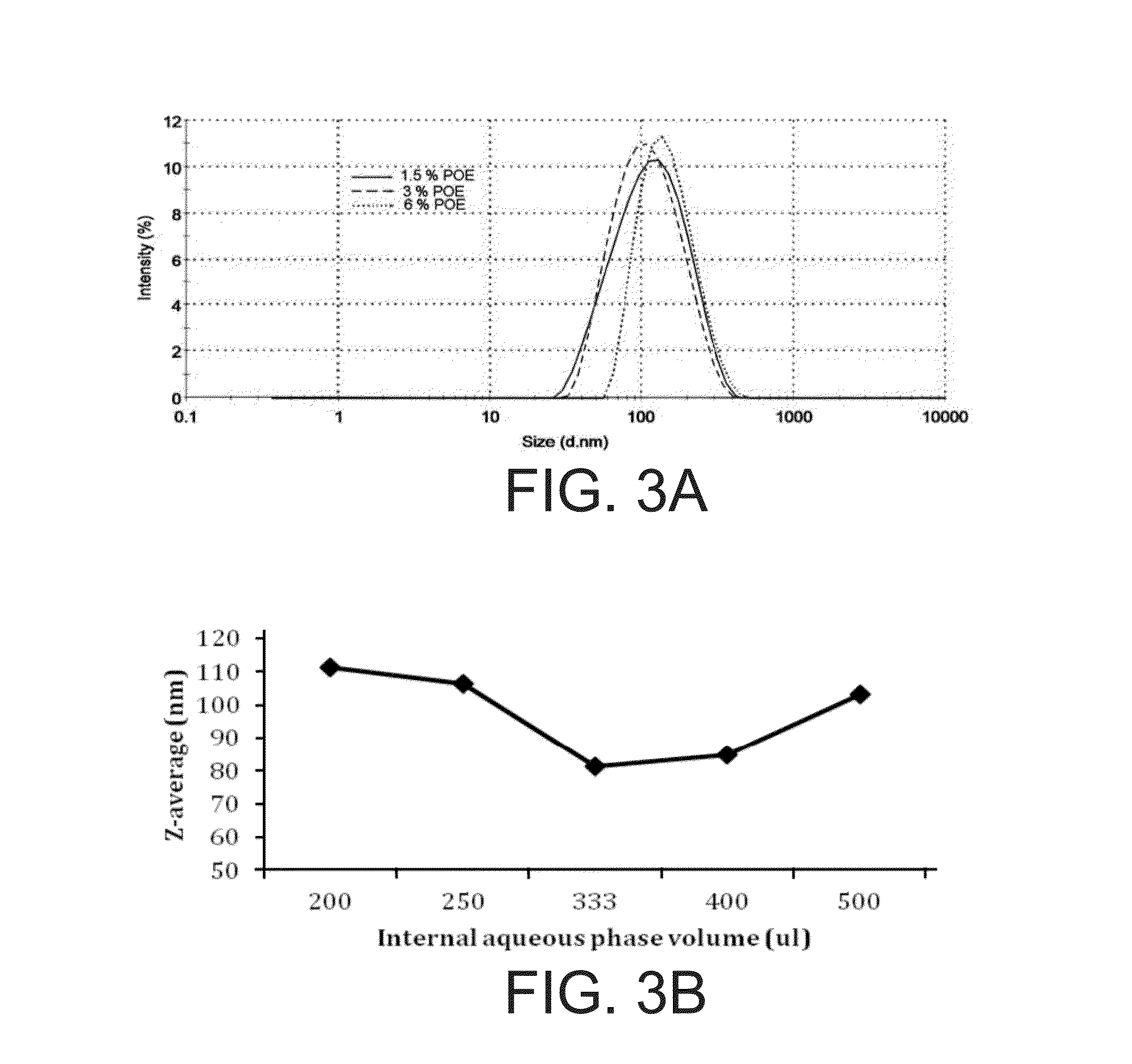Nanoparticle composition and methods to make and use the same
a technology of nanoparticles and compositions, applied in the direction of microcapsules, peptides, medical preparations, etc., can solve the problems of limiting the efficacy of drug delivery to chronic diseases and disorders, economic burden estimated at $25 billion in lost gross domestic product, and costing the united states approximately $500 million annually, etc., to achieve high encapsulation efficiency, reduce the effect of encapsulation
- Summary
- Abstract
- Description
- Claims
- Application Information
AI Technical Summary
Benefits of technology
Problems solved by technology
Method used
Image
Examples
example 1
[0117]In a preferred embodiment, hydrophilic drug loaded nanoparticles were formulated using a double-emulsion solvent evaporation system.
[0118]Typically, 2-4 mg of hydrophilic drug were dissolved in 0.1 ml distilled water, and 30 mg of poly(ortho ester) were dissolved in 1 ml of Dichloromethane:acetone (8:2) solvent mixture containing 0.05% Pluronic F68. The aqueous drug solution was added to the poly(ortho ester) organic solution and a water-in-oil (W / O) emulsion formed by sonication over an ice bath using a probe-type sonicator operating at 60% amplitude intensity for 2 min. This W / O emulsion was further added to a 2.5% poly(vinyl alcohol) aqueous solution with sonication to achieve the water-in-oil-in-water [(W / O) / W] double emulsion system. The organic solvents were allowed to evaporate while being stirred first at atmospheric pressure for 16 h and then at gradually reduced pressure (from 100 mmHg to 30 mmHg) for 2 h. The solidified nanoparticles were collected by ultracentrifug...
example 3
[0132]A novel glycan binding protein thought to be a cell surface receptor has been discovered in the retina. An issued U.S. Pat. No. 8,092,825 (hereby specifically incorporated by reference in its entirety) disclosed methods of treatment for retinal diseases and conditions including age-related macular degeneration, genetic-based retinal degenerations and retinal detachment.
[0133]Methods for intraocular injections rabbits or mice are anesthetized with an intramuscular injection of ketamine / xylazine / acepromazine cocktail or intraperitoneal injection of Avertin or inhalation of isoflurane, Corneas are anesthetized with 0.5% proparacaine. Pupils are dilated with Cyclomydril. A small incision is made in the conjunctiva and a 30 awg needle is inserted to puncture the sclera below the ora serrata. Triantennary N-linked oligosaccharide (NA3), blank nanoparticles and NA3-loaded nanoparticles are injected into the superior temporal aspect of the vitreal cavity of the left eyes. With the ass...
example 4
Poly(Ortho Ester) Nanoparticle-Based Targeted Intraocular Therapy for Controlled Release of Hydrophilic Molecules
[0136]Development of an efficient intraocular drug delivery nano-system remains the most difficult challenge to attain a prolonged therapeutic effect at the site of drug action. The purpose of this work was to develop a biodegradable, long-term sustained release, and biocompatible nanoparticulate system to treat various intraocular diseases. To attain this objective, poly(ortho ester) a hydrophobic, surface erodible and non-toxic polymer, was selected for the fabrication of nanoparticles for the first time using a double emulsion solvent evaporation (DESE) method. The influence of poly(ortho ester) molecular weight on particle size, polydispersity index, zeta potential, drug content, in vitro release, degradation, in vitro cytotoxicity and cell uptake studies was investigated. Drug-loaded nanoparticles had a spherical shape with an average particle diameter from 241 to 29...
PUM
| Property | Measurement | Unit |
|---|---|---|
| polydispersity | aaaaa | aaaaa |
| diameter | aaaaa | aaaaa |
| diameter | aaaaa | aaaaa |
Abstract
Description
Claims
Application Information
 Login to View More
Login to View More - R&D
- Intellectual Property
- Life Sciences
- Materials
- Tech Scout
- Unparalleled Data Quality
- Higher Quality Content
- 60% Fewer Hallucinations
Browse by: Latest US Patents, China's latest patents, Technical Efficacy Thesaurus, Application Domain, Technology Topic, Popular Technical Reports.
© 2025 PatSnap. All rights reserved.Legal|Privacy policy|Modern Slavery Act Transparency Statement|Sitemap|About US| Contact US: help@patsnap.com



